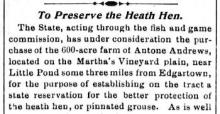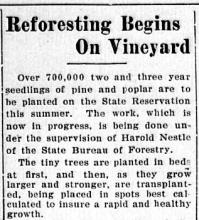A large parcel of land along the Edgartown Great Pond, which is now planned for an 18-hole golf course, was the subject of a legitimate and equivalent offer for purchase from a prominent and well-funded conservation group about 18 months ago, the Gazette has learned.
Spokesmen for The Nature Conservancy confirmed this week that an offer to buy the MacKenty-Bigelow land was made in the fall of 1997 in the form of joint proposal from the Conservancy and the Martha’s Vineyard Land Bank. And contrary to statements made some months ago by one member of the MacKenty family, the conservation leaders said the offer was legitimate.
“Yes, absolutely. We were making a real offer, and the overall offer we submitted was competitive with my understanding of what was offered by others,” said Bob Wilbur, who is the associate director of land protection for the Massachusetts chapter of The Nature Conservancy. Mr. Wilbur was designated by the Conservation Partnership of Martha’s Vineyard as the lead person in land purchase negotiations with the MacKenty and Bigelow families.
The families have now signed an agreement to sell some 200 acres of their Great Pond land to a golf course development group for a reported price of between $10 and $11 million. The developers of the project are Rosario and Barry Latucca, a father and son team from Natick. Boston developer and Vineyard seasonal resident Richard Friedman is also assisting with the project. The group is called the Meetinghouse Golf Club.
The sale of the property is contingent on approval of the golf course plan, which is now pending before the Martha’s Vineyard Commission as a development of regional impact (DRI). A public hearing is set to open on Jan. 28 on the Meetinghouse Golf Club proposal. A second golf club proposal, planned for the Old Vineyard Acres II subdivision in Edgartown, is also pending before the commission as a DRI; a public hearing and subsequent review of that project is expected to begin in February. The public review process for both golf projects is expected to go on for a number of months.
Eleven months ago, Jeremiah Mac-Kenty told the Gazette that the family had never received a bona fide offer from any conservation group for its land.
Questioned about the issue this week, both Mr. Wilbur and Tom Chase, manager of the Vineyard and Nantucket bioreserve for the Conservancy, said the facts have not been reported accurately surrounding the talks between conservation groups and the members of the MacKenty and Bigelow families.
Mr. Wilbur and Mr. Chase both would not discuss certain details including exact purchase price, because they said their offer is still on the table and they are sensitive to the needs of the MacKenty and Bigelow families.
“The offer has always been on the table and we have never been asked before now. We haven’t made any public statements because we want to preserve a healthy relationship with the Mac-Kentys,” Mr. Chase said.
But both Mr. Chase and Mr. Wilbur said bluntly that their offer to buy the family land was legitimate, competitive and included an anticipated closing date of December 1997. It is understood that the early closing date was in part because one member of the family had an immediate need for cash.
It is also understood that the terms of the offer were framed around a number of innovative options which would honor the wishes of family members to transfer most of their wealth to their children. Although the actual details of the options have not been disclosed, Mr. Wilbur did discuss in general terms the kind of tax saving techniques which can be used in transferring land interests to children. These techniques include creating a charitable remainder trust or what is known as a wealth replacement trust, which involves using a life insurance policy with the children named as beneficiaries.
“We were willing to combine those techniques in a way that was advantageous to them. We didn’t want to be telling them what to do, we only wanted to suggest a few options,” Mr. Wilbur said.
Mr. Wilbur said the result was an offer to the MacKenty and Bigelow families which matched other offers in net — or after tax — dollars.
Earlier reports that the conservation offer amounted to some $3.6 million were in fact “well below what we had offered,” Mr. Wilbur said.
The MacKenty and Bigelow land purchase is complicated in part because it involves three contiguous parcels of land owned by three siblings. The families have been represented in the land negotiations by Stephen Carr Anderson, an attorney who owns his own firm in Boston. Reached at his office yesterday, Mr. Anderson did confirm that the MacKenty and Bigelow families received an offer from The Nature Conservancy. As to whether the offer was bona fide, Mr. Anderson said: “There was a bona fide offer for some of the land.” He would not comment on whether the offer was competitive.
Asked whether an offer is still on the table, Mr. Anderson replied: “There is no outstanding offer that I am aware of. They [The Nature Conservancy] may be willing to speak to my clients again, but I haven’t confirmed that.”
Much of the discussion in recent months surrounding the golf course proposals on the Vineyard has centered mainly on two land use alternatives — golf courses versus houses.
In their interview with the Gazette this week, Mr. Chase and Mr. Wilbur also responded to the broader question of whether the Vineyard conservation groups are able to compete for the rapidly diminishing available land against the backdrop of heavily funded developers, including golf course developers.
“There is no question that with the kind of money around now that conservation groups are facing a greater challenge than we realized a couple of years ago,” Mr. Chase said. He continued: “The stakes are high, and it’s a different kind of development we are seeing with trophy houses, removal of habitat — and golf courses are inherently part of this social and economic change. But this is not so much about the conservation groups competing with developers as it is about the choices that Islanders have to make. We are only an expression of the public’s will. If the community wants to develop the Island, then they can do that. But it is a choice.”
Concluded Mr. Wilbur: “I do think it is valuable for the owners and the public to know that the offer is still on the table, and that conservation is still a viable alternative.”









Comments